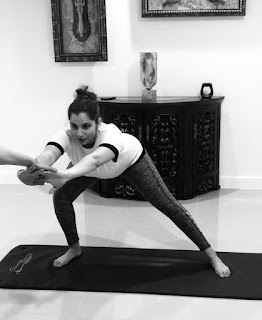is filled with joy and anticipation, on the other there are worries about
whether the baby will be normal and healthy.
As the mother’s body changes, there are mood swings, fatigue, cramps,
difficult breathing.
Benefits:
Being physically fit and emotionally strong directly affects
the baby’s physical, neurological & psychological development.
Practicing Prenatal Yoga during pregnancy gives you the
ability to stay calm and eases most physical problems during these nine months.
Prenatal yoga experts and medical professionals emphasise
that prenatal yoga paired with cardiovascular exercises (such as walking) can
ease the discomforts of pregnancy and help you prepare for the rigors of
labour.
Pranayama, or the group of several breathing exercises, have
been found to have exceptional benefits during pregnancy.
It must be incorporated in the daily regime all through the
three trimesters as it helps release negative emotions.
Two most useful forms of pranayama or breathing exercises
are:
Ujjayi, a long, strong, deep breath that helps women
redirect their concentration to the present moment and maintain calm; and
Nadi Shodhana, (alternate nostril breathing), which helps to
balance the body’s energy flows. However, avoid any kind of breath retention or
hyperventilation that could limit the baby’s oxygen supply. The postures and exercises differ for each of
the three trimesters of pregnancy.
First Trimester (0 to 13 weeks):
The first trimester brings nausea and fatigue. Severe
biological and musculoskeletal alterations take place in the body. Yoga experts
advise that one must be extremely cautious while practicing yoga in this
trimester as a wrong posture can obstruct the implantation of the fetus and
placenta.
The following asanas are ideal for this trimester:
- Marjariasana(cat stretch): Stretches the neck and shoulders,
lessening body stiffness and keeps the spine flexible because the back has to
support more body weight as the pregnancy advances. - Konasana(standing sideways bending arm): Keeps the spine
flexible and helps alleviate constipation, a common symptom of pregnancy.
- Badhakonasana(butterfly
pose): Improves flexibility in the hip and groin region, stretches the thighs
and knees, relieving pain, alleviates fatigue and helps facilitate smooth
delivery when practiced until late pregnancy. - Yoga Nidra (yogic sleep): Reduces tension and anxiety, helps
regulate blood pressure and relaxes every cell in the body.
Second Trimester (14 to 28 weeks):
During the second trimester, the volume of blood in the body
expands 50-60% to support the fetus and placenta, the blood circulates faster,
the rate of metabolism increases and heart rate rises. The body’s sugar gets
used up faster and important reserves are used to support the placenta and
fetus.
The following asanas are beneficial during this trimester:
- Vajrasana(diamond pose) –Enhances digestion and can be done
directly after meal.It also helps strengthen the pelvic muscles and assist
women in labour too. - Kati Chakrasana(spinal twist pose) – Relieves physical and
mental tension and tones waist, hip and back.
- Tadasana (mountain pose)– Helps stretch and loosen the
entire spine and also helps in developing mental and physical balance. - Uthanasana(standing forward fold)– Strengthens muscles of
uterus, thighs, back and ankles.
Third Trimester (29 to 40 weeks):
By the third trimester, the body has already undergone
drastic physical and biological changes and also the movement of the baby is
strong now. The protruding belly and additional weight are likely to challenge
one’s balance.
aligned. It is advisable to practice yoga with a prenatal teacher at this
stage. If you ever feel uncomfortable doing any posture, stop.
Basic balancing postures like Utthita Trikonasana (extended
triangle pose), Utthita Parsvakonasana (extended side angle pose),
Virabhadrasana (hero pose) and Vrksasana (tree pose) are ideal for building
strength in the legs, for proper alignment in the spine and for easing blood
circulation
yoga drastically lowers the chances of pregnancy complications, stress levels
and pain, and possibly even the risk of the baby being small for her
gestational age.




